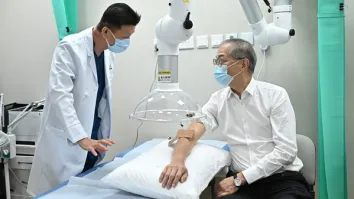Moving telehealth from a temporary fix to a pillar of modern healthcare
By Dave O’ShaughnessyOver the past few years, teleconsultations have played a growing role in the delivery of healthcare and support services across ASEAN.
Once reserved for out-of-country patients or those with restricted mobility, COVID-19 has seen telehealth expand to deliver essential services when restrictions limited the number of patients allowed on-premises.
Far from a stop-gap measure, these services are set to become one of the standout legacies from the global pandemic.
Ernst and Young found a surge in demand for telemedicine services by both patients and physicians across ASEAN, indicating confidence in the method and a lasting appetite for its convenience.
Indeed, the benefits offered by teleconsultations are broad and far-reaching, and many of them slot perfectly into the gaps that persist across the region’s healthcare sector.
Research has identified inadequate physical infrastructure and a lack of skilled healthcare workers as among the top issues plaguing ASEAN’s low-income and middle-income countries. With the availability of video-conferencing services, patients no longer need to leave their homes to receive care, and providers can ensure those in inaccessible areas aren’t left behind.
In Indonesia, for instance, telehealth consultations have been identified as a way to improve the accuracy and efficiency of medical diagnoses in areas with limited resources, such as remote islands and mountainous locations. They can also address geographical challenges when skilled healthcare workers are permanently stationed in these places.
While demand for telehealth services has spiked, there is also a degree of skepticism around its long-term viability.
Dr Peter Pronovost, a renowned expert in medical innovation encapsulated this attitude best: “There’s a lot of focus on shiny objects, rather than on solving problems.”
It’s true providers cannot rely purely on telephony or simple video-conferencing software and expect it to provide a comparable experience to a traditional hospital or doctor’s office.
Given the challenges around in-person availability, patients across ASEAN might avoid seeking healthcare altogether if the telehealth experience is not easy to navigate and free of excessive wait times or interruptions.
On the provider side of the coin, a clunky or ineffective solution could increase the administrative workload for staff, exacerbating stretched resources and ultimately driving more people away from the healthcare sector.
A dent in the talent pool could seriously escalate the health crisis in Singapore, for instance, where 1,500 staff resigned in the first half of 2021, compared with 2,000 annually before the pandemic.
Not just a shiny object
Healthcare organisations need to create a telehealth environment from the ground up, one that addresses the specific pain points felt by people across the region.
This begins with a unified system that can integrate with existing applications, allowing healthcare providers to seamlessly expand capabilities, thereby easing the frustration that comes with fragmented encounters between staff and patients.
A solution that enables flexible integrations saves staff from trawling through external systems to access patients’ medical histories and referrals, readily drawing upon electronic medical records (EMRs), decision support and diagnostics systems to provide patients with uninterrupted virtual experiences.
Research has found a lack of interoperability between healthcare providers in ASEAN is elongating referral processes and causing unnecessary re-evaluations if patients have to move between facilities. A unified system can go a long way toward streamlining this process and saving time.
In a practical example, healthcare organisations can reduce the duration of individual consultations by rolling out a secure, virtual waiting room that patients can access with dedicated, private web links. This allows them to be automatically identified, authenticated, and admitted to a virtual doctor’s office, providing visibility over the journey and closely mirroring traditional healthcare visits.
Patients should also be empowered to book appointments, receive medical advice and complete payment processes in the one spot. If each step of their journey involves separate applications, with different login credentials and interfaces, administrative staff will expend time and resources explaining each process, hindering the overall impression of care and support.
Additionally, this flexibility will allow providers to easily expand upon telehealth solutions when new technologies and processes emerge across the industry. Some hospitals, for instance, have begun creating a telehealth ‘metaverse’, extending healthcare beyond isolated consultations to include pre and post-care, the delivery of medication, and more.
Two of Southeast Asia’s largest hospital operators, for example, have begun experimenting with augmented reality as part of their telehealth services, with plans to use artificial intelligence (AI) and machine learning technology to provide outpatient counselling and to remotely monitor patients in intensive care units. To leverage these initiatives with minimal set-up time and disruption to services, a unified system that can seamlessly draw upon historical patient information is essential.
Telehealth is poised to become a crucial pillar across ASEAN’s healthcare sector, not only to compensate for scarce resources and navigate pandemic mandates but to ensure the delivery and availability of healthcare is the same for all people, regardless of their location.
To elevate the experience beyond simplistic measures and provide services that are on the same level, or even better, than traditional healthcare appointments, these environments need to address the needs of patients and healthcare staff, and be flexible, adaptable, and geared for the challenges of the future.




















 Advertise
Advertise








